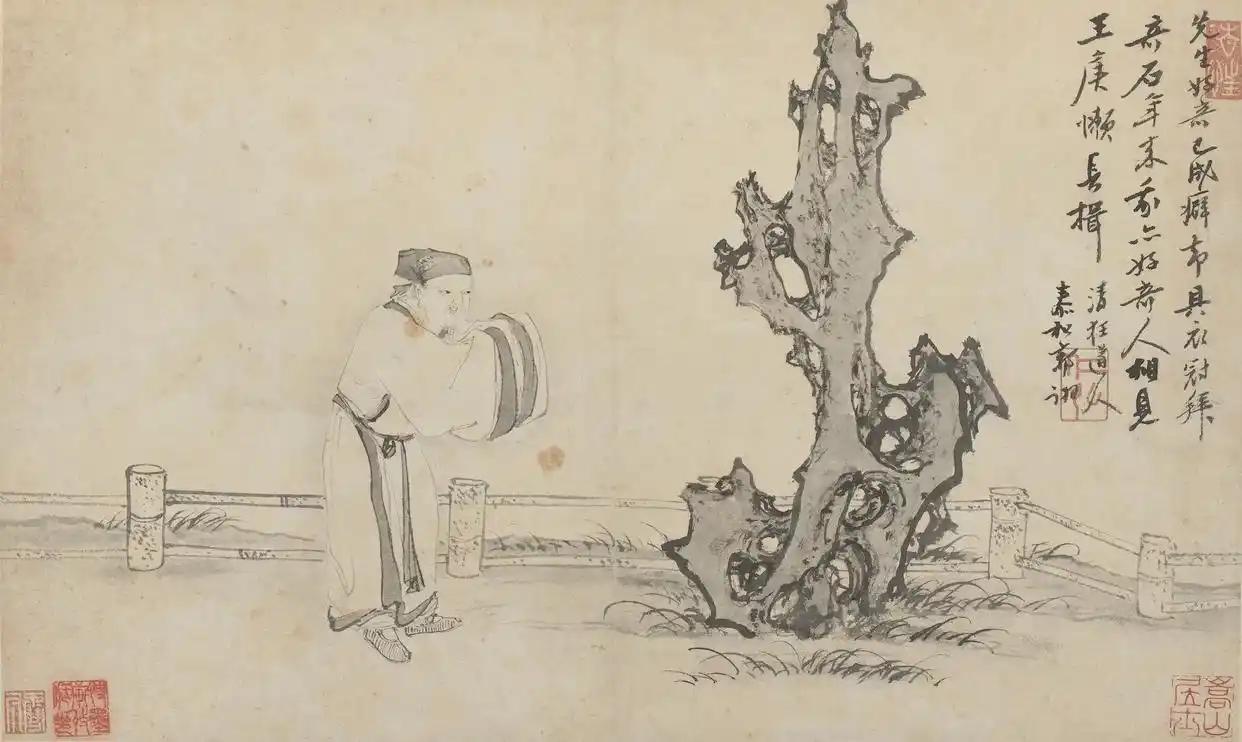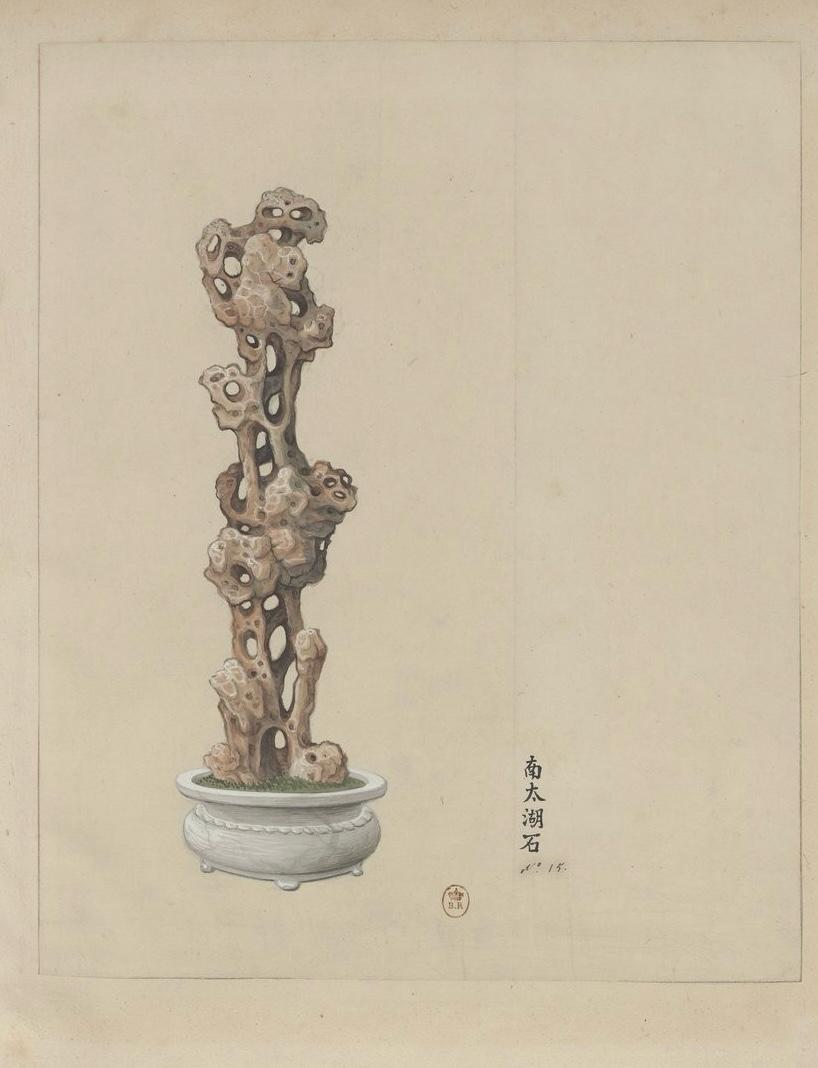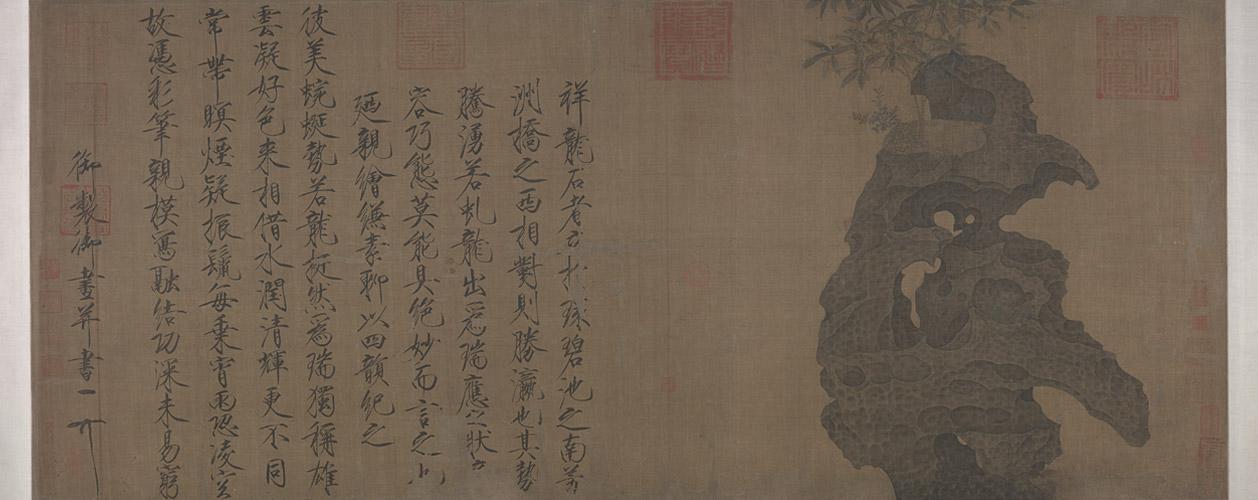The theory of the five Elements (i.e. water, fire, earth, wood and metal) as a deep understanding of natural law and of human cultivation through interaction with nature is deeply woven into the fabric of Chinese culture, including traditional medicine and the Chinese zodiac. The rocks and stones discussed in this essay are regarded as “the bone of the earth” and share the same intellectual sophistication as Chinese thought related to matter in general. As early as the Han dynasty, Shen Nong Ben Cao Jing (Pharmacopoeia of the Heavenly Husbandman) identified different kinds of minerals as remedies, some of them being from rocks. Shi Yao Er Ya (Synonymic Dictionary of Minerals and Drugs) from the Tang dynasty, an import treatise on minerals by Mei Biao, was actually a book for alchemists exploring possible transformations between different types of matter under certain conditions. Nevertheless, during the Song dynasty, owing to the proliferation of scientific monographs devoted to specialized subjects, a whole series of books emerged that focused on stones and minerals, such as rock catalogues. The starting point for these studies, however, was aesthetic rather than medical.1 Meanwhile, Chinese literati contributed to the aesthetics of rocks through a delicate appreciation and image-making connected to the forms and materiality of rocks. Indeed, aesthetics has always played a pivotal role in rock culture that far transcends medicine and mystery.
In one of his poems about rocks from “An Account on Lake Tai Rock” (太湖石记), the Chinese poet from the Tang dynasty Bai Juyi claims, “Unlike poetry, music, and wine, the rocks have no patterns or sound or smell or taste.”2 Nonetheless, Bai Juyi is undoubtedly one of the most famous connoisseurs of rocks throughout Chinese history. In fact, few civilizations have revered stones and rocks as much as the Chinese. Petrophilia, or the adoration of rock, has a remarkable tradition in Chinese culture that could even go back as far as two thousand years. Rocks were initially arranged in the emperor’s parks, as a prerogative of the imperial family. Later, this enthusiasm spread to the literati and common people, as the symbolism associated with rocks during the Tang dynasty became even more pronounced on multiple levels. This vogue of rock appreciation became even more popular during the Song dynasty when rock catalogues (“石谱”) from various authors appeared. It is especially noteworthy that the rocks or stones in question here certainly do not include crystals or jewels that are treasured in many civilizations. Instead, this essay focuses on what are often referred to as “common rocks” that are identified with special characters and endowed with profound symbolism by Chinese literati and intellectuals.
In the Chinese imagination, rocks are not merely the object of fetishism, given that they carry their own subjectivity and spirit. In exploring how Chinese literati integrate rocks and images of them laden with symbolic meaning into their own lives, I also underscore how their tastes related to the “ideal” rock (especially Lake Tai Rock) inform their aesthetic sensibilities overall. From an interdisciplinary angle, I further probe the metaphysical and spiritual origins of this petrophilia that are inextricably linked to Chinese Daoist philosophy. As an object of projection or contemplation, rocks play an important role in both the collective and personal imagination of Chinese people. As I underscore unique Chinese sensibilities, I will also return to the Western tradition as a counterpart when necessary.
I Petrophilia: Stone as a Companion Species
The interaction between human beings and the natural world, in addition to the ecological interdependency that these quotidian encounters entail, is initially deeply connected to the birth of agriculture in China. In the case of rocks, stone worship related to various pantheistic divinities existed from the very beginning. In the Han rhapsodic Fu, vivid descriptions of rocks became very common in “poetry on objects” (yongwushi 咏物诗). Nevertheless, as Xiaoshan Yang points out, “In this genre, the poetic rock lacks specificity as a physical object and functions instead as an emblem whose meaning can be easily decoded. The poet evidences little material relationship with the rocks he describes.”3 In other words, the rock in this context is a concept that is deprived of its own materiality. 4It is essentially a fixed item attached to a socially constructed symbolism. Thus, its materiality does not affect the spectator physically.
From a historical perspective, it is later including the ninth century that the physical interactions between stones and humans come into play. Stones would become a “companion species” for their owner. As Xiaoshan Yang reveals, “These new orientations are illustrated in the poetic representation of the Lake Tai rock from the mid-Tang to the Northern Song.”5 From this point on, stones were deeply appreciated and endowed with a sort of subjectivity, thereby playing the role of a companion species in the daily life of the literati. While serving as an administrator in Suzhou, a city near Lake Tai (Tai Hu), Bai Juyi was overwhelmed by the bizarre and grotesque features of a couple of Lake Tai rocks. He took them back home and “domesticated” them. Bai derived much inspiration and satisfaction from being with these stones. In the poem “A pair of Rocks”(Shuangshi 双石), Bai addresses these rocks as close friends: “Turning my head around, I ask the pair of rocks: Can you keep company with an old man like me? Although the rocks cannot speak, they promise that we will be three friends.”6 His friend Niu Senru, the prime minister at the time, was so obsessed with stone collection that he made painstaking efforts to classify them appropriately. According to Bai, he “treats them [the rocks] as noble friends, respects them as great philosophers, treasures them as jewelries, and loves them as his own descendants.”7 Or, as Niu himself claims, he admires and loves rocks as much as one would an older brother: “As if facing a brother ten years my senior.”8
The artist Mi Fu from the Song dynasty is widely considered by historians to be the ultimate connoisseur of rocks. As he was traveling to assume the responsibilities of a magistrate in Wuwei county in Anhui, a region famous for its stone, he suddenly saw a stone with a grotesque shape standing upright in the municipal garden. In a state of shock, he immediately bowed to it in a sign of respect and admiration before addressing it as “Elder Brother Rock.”9 This Mifu anecdote was frequently represented by Chinese artists in later periods, such as GuoXu from the Ming dynasty(Figure 1). Through the act of submission and obedience, Mi Fu gives up his own subjectivity surrendering himself completely to the rock. During these poignant instants, the rock becomes the dominant object, as opposed to playing a passive role, in terms of fetishism. For these artists the rock was not merely an object but what today we would call a companion: an entity possessing equivalent subjectivity.




